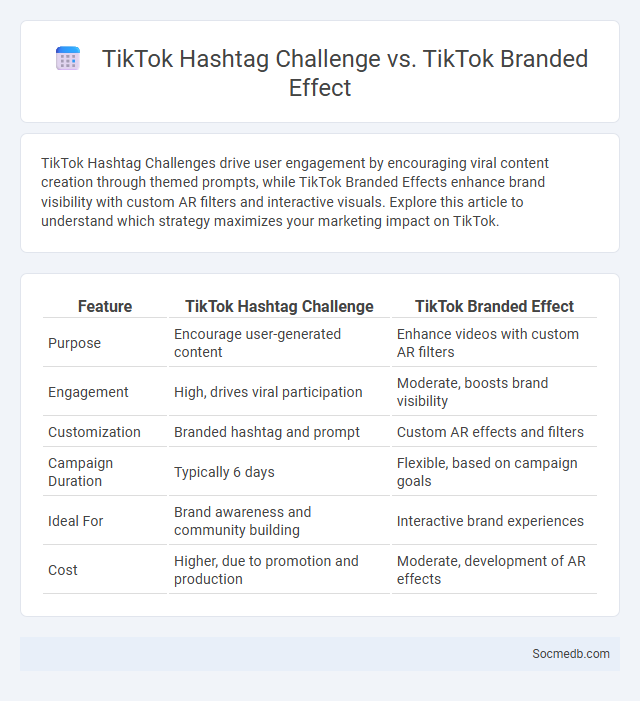
Photo illustration: TikTok Hashtag Challenge vs TikTok Branded Effect
TikTok Hashtag Challenges drive user engagement by encouraging viral content creation through themed prompts, while TikTok Branded Effects enhance brand visibility with custom AR filters and interactive visuals. Explore this article to understand which strategy maximizes your marketing impact on TikTok.
Table of Comparison
| Feature | TikTok Hashtag Challenge | TikTok Branded Effect |
|---|---|---|
| Purpose | Encourage user-generated content | Enhance videos with custom AR filters |
| Engagement | High, drives viral participation | Moderate, boosts brand visibility |
| Customization | Branded hashtag and prompt | Custom AR effects and filters |
| Campaign Duration | Typically 6 days | Flexible, based on campaign goals |
| Ideal For | Brand awareness and community building | Interactive brand experiences |
| Cost | Higher, due to promotion and production | Moderate, development of AR effects |
Introduction to TikTok Marketing Formats
TikTok marketing formats encompass in-feed ads, branded hashtag challenges, and branded effects, each designed to engage users through creative and interactive content. In-feed ads appear seamlessly within users' For You feed, allowing brands to reach diverse audiences with short, captivating videos. Branded hashtag challenges encourage user participation by prompting content creation around a specific theme, while branded effects offer custom filters and augmented reality experiences to boost brand visibility and engagement.
What is a TikTok Hashtag Challenge?
A TikTok Hashtag Challenge is a user-driven campaign that encourages participants to create and share videos based on a specific theme or trend, using a designated hashtag to track engagement. This interactive format boosts visibility, fosters community involvement, and can rapidly increase the reach of your brand or content on the platform. By leveraging viral trends and creative user participation, TikTok Hashtag Challenges drive organic growth and elevate audience interaction metrics.
Overview of TikTok Branded Effects
TikTok Branded Effects offer businesses a unique way to engage users through customized filters, stickers, and augmented reality experiences tailored to enhance brand visibility. These interactive tools leverage TikTok's vast user base, enabling You to create immersive campaigns that boost audience interaction and increase brand recall. By integrating Branded Effects into your marketing strategy, you tap into cutting-edge technology that drives user-generated content and viral sharing.
Defining the Standard Hashtag Challenge
The Standard Hashtag Challenge on social media involves creating a specific hashtag that encourages users to participate in a viral trend by sharing related content under the same tag. This approach boosts engagement, increases brand visibility, and makes content easily discoverable across platforms like Instagram, TikTok, and Twitter. By leveraging the power of hashtags, you can unite your audience and amplify the reach of your campaign efficiently.
Key Features of TikTok Hashtag Challenges
TikTok Hashtag Challenges encourage user-generated content through trending themes, boosting engagement and virality across the platform. These challenges leverage short-form video formats and music integration, enabling users to participate creatively and share widely. The algorithm promotes these challenges on the For You page, maximizing visibility and driving community interaction.
Unique Benefits of TikTok Branded Effects
TikTok Branded Effects offer unparalleled opportunities for businesses to create immersive, interactive content that drives user engagement and enhances brand visibility. These customized AR filters and effects enable brands to connect with younger audiences through creative storytelling and viral challenges. Leveraging TikTok's algorithm, Branded Effects amplify reach organically, fostering authentic consumer interactions and boosting conversion rates.
Comparing Engagement Levels
Engagement levels on social media vary significantly across platforms, with Instagram averaging a 1.22% engagement rate per post, while Facebook sees around 0.08%. TikTok outperforms both, boasting engagement rates upward of 5%, driven by its video-centric algorithm and user demographics. Analyzing metrics such as likes, comments, shares, and watch time provides deeper insight into user interaction and content effectiveness across channels.
Costs and Budget Considerations
Social media marketing costs vary widely, with paid advertising campaigns typically requiring budgets ranging from $200 to $40,000 per month depending on platform and reach. Content creation expenses, including graphic design and video production, average around $1,000 to $10,000 monthly for small to medium businesses. Budget considerations should also include social media management tools, which cost between $50 and $500 per month, and potential costs for influencer partnerships, which vary based on influencer reach and engagement.
Choosing the Right Format for Your Brand
Selecting the optimal social media format for your brand depends on understanding your target audience's preferences and platform-specific engagement patterns. Video content tends to drive higher interaction rates on platforms like Instagram and TikTok, while infographics and carousel posts work well for educating followers on LinkedIn and Facebook. Tailoring content format to align with brand messaging and platform algorithms maximizes visibility and strengthens audience connection.
Conclusion: Maximizing TikTok Campaign Success
Maximizing TikTok campaign success requires a strategic approach that prioritizes engaging, authentic content tailored to your target audience's preferences. Utilizing TikTok's advanced analytics tools enables you to track performance metrics and refine your campaigns for greater impact. You can achieve higher conversion rates and brand visibility by consistently testing creative formats and leveraging trending hashtags to enhance discoverability.
 socmedb.com
socmedb.com